For me here at Oakwood good carp care is vitally important. We owe it to our beloved carp to fish responsibly, handle, treat and release them in the safest way possible so they always remain in the best health, ensuring they always live to fight another day. Whether it’s a 10lb carp or a 40lb carp they should all be treated in the same way, as some of the little ones will one day become the ones we are after!
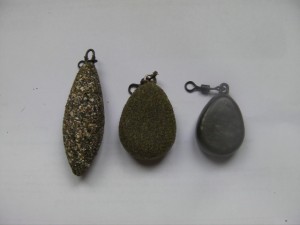
Rough coated or smooth leads?
Good carp care first applies to sensible fishing and using safe rigs. Tubing on the main line can help prevent scales being removed during the fight which could lead to infection and more fish friendly hooks patterns is a good place to start along with lead coatings.
“Lead coatings” I hear you say, during the last few years I swapped lead manufacturer. I was using the smooth coated leads but was fishing a sandy, gravel bottomed lake at the time so needed something different to blend in. Off I went to the local tackle shop and purchased some great looking leads that matched the bottom perfectly, rough coated ones.
I set about my fishing and started to catch my quarry. Now when I have a carp in the net I always bite my line and remove the lead before I lift the carp out of the water and I started to notice that the leads were covered in fish mucus. I watched this over a period of time and it was clear that the rough coating was removing the carp’s natural protective layer. To what extent I don’t know but food for thought as this is clearly not a good thing! I have now changed back to the smooth ones because of this.
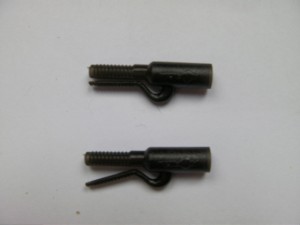
Clips may need to be opened slightly first so the lead can release easily.
There’s has been a multitude written on various rigs over the years so I will let you decide which one you choose, you just need to make sure everything releases properly so the carp is not left towing around anything except the hook link should the mainline break. Leads, beads, rig tube and anything else used should drop off the main line easily.
Developments in angler’s rigs and in the rig components used have advanced enormously in recent years. Lead release clips are great but make sure you wet the tail rubber before casting out and don’t wedge them on too tight otherwise it won’t do the job it was meant for! The tail rubber also accepts rig tube which creates a nice simple, no tangle rig and if you dab a little superglue on the end of the rig tube before you insert it into the tail rubber this will ensure it does not ride up the mainline during the battle.
Personally I’m not a fan of leaders unless absolutely necessary. In some situations they are required, such as fishing over high gravel bars etc, to avoid cut offs but come on guys how safe is something you can’t break with your hands, let alone expect a carp to break should it become tethered, safezone I think not!
After a line break the carp is left towing around the hook link and a leader or leadcore. The carp will obviously try and get rid of the unwanted hook and head straight to the nearest snag or weed bed for assistance.
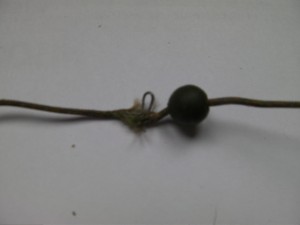
If this happens to leadcore it creates a death rig
Whilst fishing France I have personally witnessed 2 dead carp due to leadcore. The first I found while fishing a lake in England. The carp had wound the leadcore around a branch and could not free the hook or break the leadcore so it effectively starved and I’m in no doubt suffered a horrible death. The second the leadcore had kinked and the lead itself was poking through the outer cover which made it impossible for the bead to pass over the lead core and dump the lead.
I pulled out the whole mess including the remains of a dead carp out of some marginal tree roots.
One bad rig is all it takes to injure or kill a Carp, don’t depend for one minute on the fish ejecting the rig themselves without injury. Such terms as “it will drop the hook” or “it will dump it in the weed” roll off the tongue fairly easily, I have heard it many times when someone has lost a fish with a rig in it, when the reality is that they will actually rip it out of their face on the first weed bed, or snag they can find!
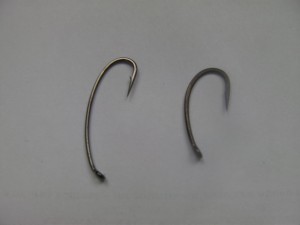
Dangerous hook patterns
This leads nicely on to hook patterns. I have conducted my own investigations into the risk of damage caused to fish’s mouths by certain hooks over the last two years. In conclusion certain hook patterns greatly increase the risk of tearing and double hooking.
Patterns that have curved shanks can cause considerable mouth damage, depending on the hook hold and are also very difficult for the carp to free themselves of should a line break occur.
The tackle manufactures need to take more responsibility in my eyes, manufacturing dangerous hooks just to make money and bulk their range’s out. It’s not really the fault of the fishing public, that are just using the latest offering presented to them by their favourite tackle manufacturer!
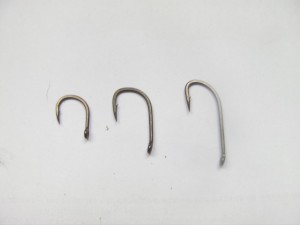
Straight shanks definitely more fish friendly!
Straight shank hooks are definitely more fish friendly and this year at my lake Oakwood Fisheries there will be a barbed hook, straight shank rule only after my findings and I urge other fishery owners to go down the same route. After all who wants to catch carp with mutilated mouths?
We have covered rigs, leaders and hook patterns in part 1, now it’s time to look at good carp care on the bank itself.
We must start when the carp has been safely guided into the landing net. Ideally a fishing partner will lend a hand here keeping the carp safe in the net, still in the water while everything is readied. For those of you that like to fish alone it’s imperative that everything is laid out in advance of your capture as you don’t want to cause harm to the carp while it thrashes about on the unhooking mat while you are looking for your camera!
You should lay your weigh sling in your Unhooking mat, water bucket, forceps and carp antiseptic should be next to your mat. I also leave my scales under the mat so they don’t get wet.
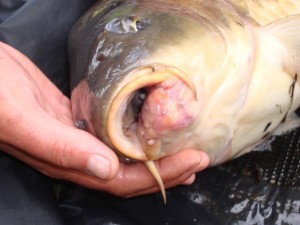
We don't want to see mouths like this!
Next it’s time to get the carp out of the water, at this point you should bite or cut your mainline to ensure as you lift the carp no tension is pulling on the hook and this also removes the awkwardness of carrying a rod, net and fish. At this point I also remove the lead as well if it hasn’t already dropped off.
You can now carefully roll down the net and lift the carp out of the water paying special attention that the carp’s pectorial fins are not being folded in the wrong direction and carefully place the carp on the mat. The fish should be lifted a few inches clear of the mat and the net slid out from underneath. This ensures if the carp does start to flap the abrasive material of the net wont mark the fish and they won’t get theirs fins caught in the net. If you ever do get a fish’s fin stuck in a net, just cut the net not rip it free as the cost of a new mesh is less than 20 pounds.
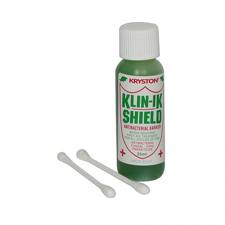
Treat all hook wounds
Next use the water bucket to wet the fish, they should be kept wet at all times while out of the water and remove the hook, paying special attention to the way the hook went in. Bend it out the same way, don’t just pull it in any direction. Treat all hook holds even if there is no visible mark with antiseptic and look over the fish to make sure no scales have been lifted and there is no other damage. Treat all wounds with antiseptic.
Now you can zip up your sling and weigh the fish as the carp is already lying in the sling on the mat and take any photographs.
The photograph time should be kept to a minimum as there seems to be too many David Baileys out there doing 10-15 minutes photo shoots, this is really unacceptable it only should take a minute or two at the most to get some great shots.
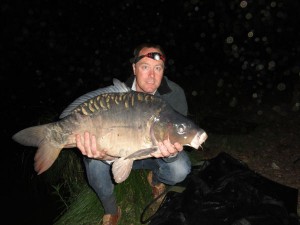
I’ve seen worse but not great handling - the carp is too high and no mat underneath.
When you are holding a carp for your trophy shot keep them as low as possible. Never more than 40cm above the mat and if you feel them tensing up and you think they are going to flap rest them back down on the mat until they have calmed down. Then pick them up again don’t wrestle with them because you will remove their protective mucus on your clothes.
Also hold them right, one hand to support underneath there head around the pectoral fin area and the other around their anal fin.
It’s now just a simple case of lying them gently back down on the mat and weigh sling, zipping the weigh sling back up and carrying them back to the water none the worse for their capture.
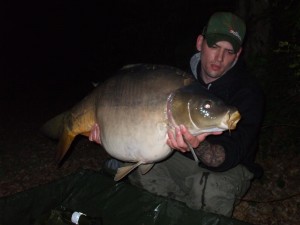
How it should be done - great hand placement and the carp in the correct position over the mat
Whilst we are on the subject of unhooking mats I think it safe to say things have moved a long way with regard to fish safety in the last few years. Companies such as JRC have been manufacturing extremely well padded mats with retaining sides, which is a big improvement on the flat mats however I think the Nash stable have moved the unhooking mat to the next level with their carp cradles.
To me the benefits are enormous, the carp is now no longer in contact with the ground so if it flaps and thrashes about on the mat it can’t suffer any internal injuries because it is suspended. The cradle’s also hold water ensuring the carp never dry out while on the mat.
On top of this when you are holding the fish for photographs your knees are placed actually under the mat so when you pick the carp up the mat is always underneath it and the height you are picking them up is reduced. One final plus is your legs don’t get wet from the mat!
By Daniel Allen – Oakwood Fisheries
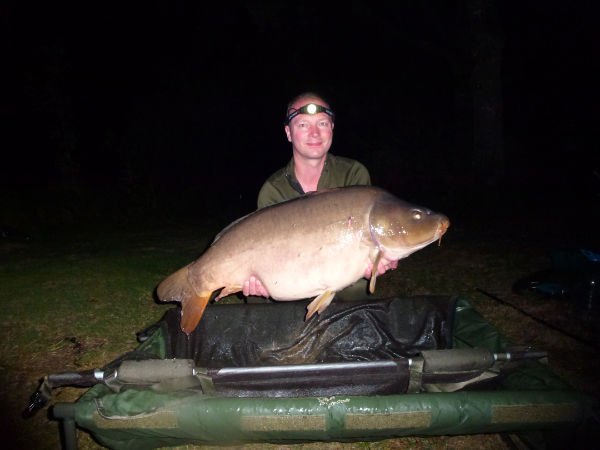
The cradle in action with an Oakwood 40. Note how the sling is laid in the cradle - perfect fish care. If this fish starts to flap it can just be lowered safely.

Another Oakwood 40 this time the fish doesn’t leave the water, it was placed on the JRC mat floating on the surface and unhooked, weighed and treated. Probably the best fish care but not everyone’s cup of tea getting in the lake!

No comments:
Post a Comment